
The U.S. Senate recently rejected an amendment in the $1.9 trillion COVID-19 relief bill that would have raised the federal minimum wage to $15 per hour. This means that millions of Americans will continue to live in states in which they can be paid as little as $7.25 for an hour of work.
Someone working 40 hours a week at the federal minimum wage level would take home just over $15,000 per year before taxes. Though a relatively small percentage of the U.S. labor force earns the federal minimum wage level, there are dozens of major metropolitan areas where the typical worker earns wages of less than $32,000 per year.
To identify the cities with the lowest paying jobs, 24/7 Wall St. reviewed the median annual wage in 389 metropolitan statistical areas using data from the May 2019 Occupational Employment Statistics program of the Bureau of Labor Statistics. It is important to note that our data reflects wages before the pandemic. It is likely that economic conditions in many of the cities on this list, and in others, have worsened and median wages in 2020 were even lower.
Out of the 25 metro areas with the lowest paying jobs in the U.S. in 2019, 23 were in Southern states. Residents of this region are much more likely to face poverty, low incomes, and other economic challenges. These are America’s richest and poorest states.
Geography is not the only deciding factor in determining income levels. An area’s income level This also depends on natural resources, local laws and regulations, and the population’s educational attainment. Workers with high school diplomas tend to earn higher wages than those without, and those with a bachelor’s degree or higher tend to earn also typically have higher wages earnings than those who have not finished college. These are the most educated cities in every state.
Click here to see 25 cities with the lowest paying jobs.

25. Deltona-Daytona Beach-Ormond Beach, FL
> 2019 median annual wage: $31,430
> Most highly concentrated occupation: Commercial pilots (5.8 times more common than national distribution)
> Annual wage of area commercial pilots: N/A (national median wage: $86,080)
> 2019 poverty rate: 12.4% (209th highest out of 383 metro areas)
In the Deltona-Daytona Beach-Ormond Beach area on Florida’s eastern coast between Orlando and Jacksonville, the median wage was just $31,430 in 2019 — one of the 25 lowest of any major metropolitan area in the U.S. The Deltona area has an outsized share of leisure and hospitality workers, a sector that generally does not pay high wages.
Though workers in the Deltona metro area generally earn relatively low wages, residents were not especially likely to struggle economically, especially when compared with other metro areas on this list. The area’s 2019 poverty rate of 12.4% was roughly in line with the U.S. rate. SImilarly, just 5.3% of households earned less than $10,000 in 2019, compared to 5.8% of American households overall.
[in-text-ad]

24. Albany, GA
> 2019 median annual wage: $31,320
> Most highly concentrated occupation: Career/technical education teachers, postsecondary (6.3 times more common than national distribution)
> Annual wage of area career/technical education teachers, postsecondary: $17,390 (national median wage: $54,620)
> 2019 poverty rate: 22.6% (10th highest out of 383 metro areas)
The Albany metro area area of southern Georgia had among the lowest wages of any American metro area in 2019, with a median of $31,320. The area has an outsized share of workers in the trade, transportation, and utilities sector, which does not tend to pay high wages.
Albany area residents are much more likely to live in poverty than the typical American. The area had the nation’s 10th highest poverty rate in 2019, at 22.6%, and the second highest share of households living on less than $10,000 that year, at 12.1%.

23. Beckley, WV
> 2019 median annual wage: $31,130
> Most highly concentrated occupation: Continuous mining machine operators (48.2 times more common than national distribution)
> Annual wage of area continuous mining machine operators: $45,660 (national median wage: $55,280)
> 2019 poverty rate: 17.9% (47th highest out of 383 metro areas)
The Beckley metro area in southern West Virginia has among the lowest paying jobs in the country. The typical worker, including part time workers, earned $31,130 in 2019 — well below the U.S. median of $39,810 that year.
Nationwide, 60.6% of Americans aged 16 to 64 reported that they usually worked more than 35 or more hours per week in 2019. In the Beckley metro area, just 50.3% of working-age residents usually worked over 35 hours per week, one of the lowest shares in the country. This relatively low share of full time workers likely contributes to the area’s low wages.

22. Auburn-Opelika, AL
> 2019 median annual wage: $31,090
> Most highly concentrated occupation: Engine and other machine assemblers (16.6 times more common than national distribution)
> Annual wage of area Engine and other machine assemblers: $28,870 (national median wage: $45,660)
> 2019 poverty rate: 15.8% (90th highest out of 383 metro areas)
The Auburn-Opelika, Alabama, metro area has some of the lowest paying jobs in the country, with a median worker pay of just over $31,000 in 2019. This figure includes part-time workers, including college students at Auburn University working part-time jobs, who are likely driving down the area’s median wage.
Certain employment sectors, like information and financial activities, tend to pay workers much higher wages. Nationwide, 1.9% of workers are in the information sector, and 5.8% work in financial activities. In the Auburn area, just 0.7% of workers are in information and 2.8% in financial activities.
[in-text-ad-2]
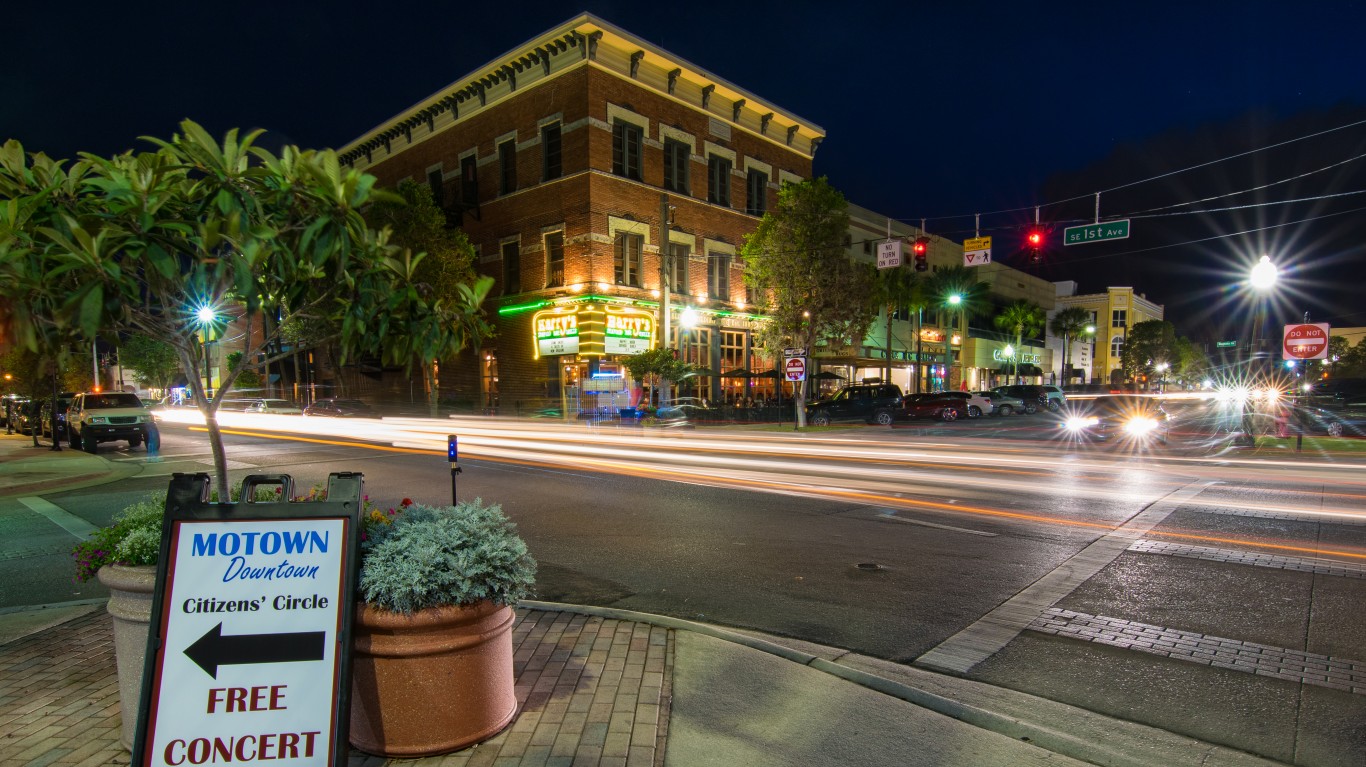
21. Ocala, FL
> 2019 median annual wage: $31,050
> Most highly concentrated occupation: Farmworkers, farm, ranch, and aquacultural animals (8.0 times more common than national distribution)
> Annual wage of area farmworkers, farm, ranch, and aquacultural animals: $26,980 (national median wage: $27,830)
> 2019 poverty rate: 15.0% (117th highest out of 383 metro areas)
Workers in the Ocala area of Central Florida earn lower wages than workers in all but 20 other major metro areas. The area’s 2019 median annual annual wage of $31,050 was well below the U.S. median of $39,810 that year.
Certain industries tend to pay much lower wages than others, and the majority of metro areas on this list have an outsized share of their workforce employed in those industries. The Ocala area is no exception. In 2019, 23.1% of workers in the area were in the trade, transportation, and utilities sector, compared to 18.4% of all American workers. Conversely, smaller shares of area workers were employed in high-paying industries such as the information and the financial activities industries.
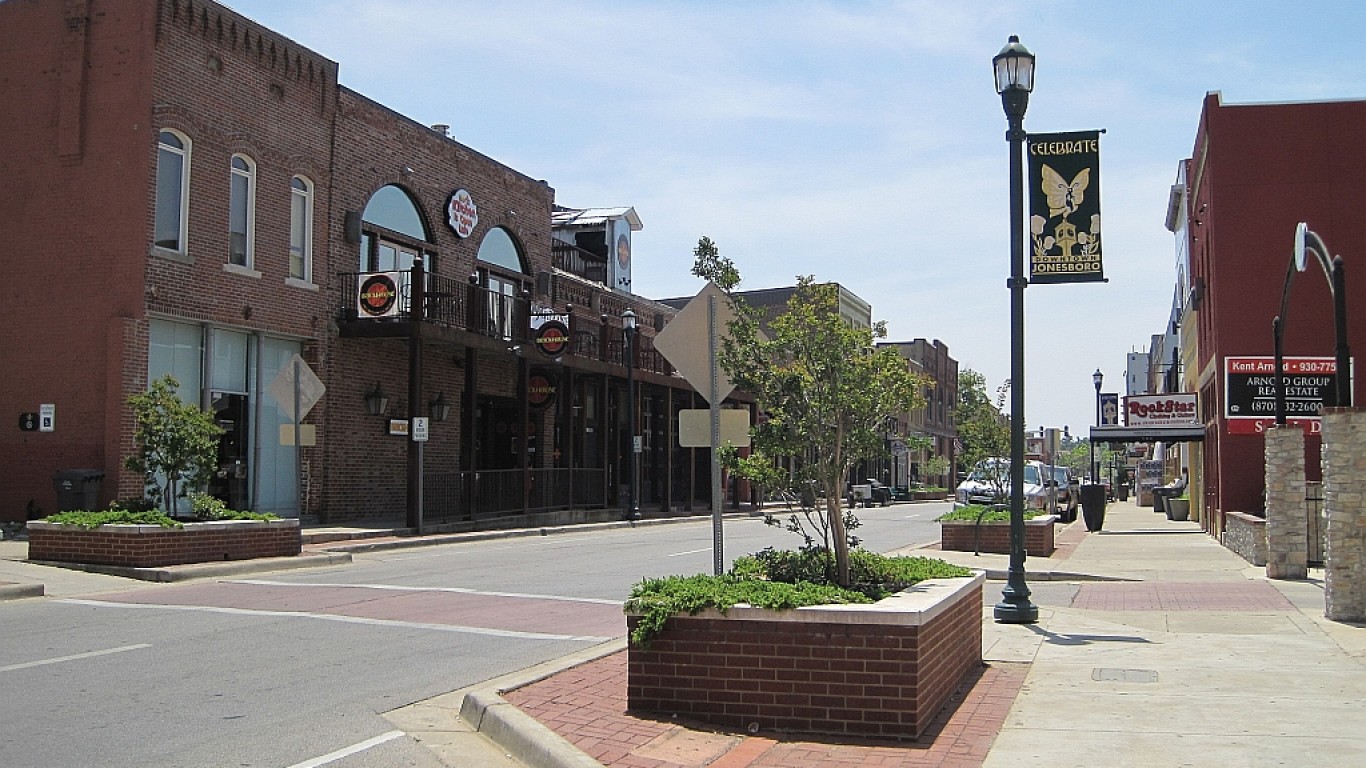
20. Jonesboro, AR
> 2019 median annual wage: $30,860
> Most highly concentrated occupation: Agricultural equipment operators (6.9 times more common than national distribution)
> Annual wage of area agricultural equipment operators: $33,310 (national median wage: $31,950)
> 2019 poverty rate: 18.9% (34th highest out of 383 metro areas)
The Jonesboro, Arkansas, metro area, located in the northeastern part of the state, is one of just 20 major U.S. population centers in which most workers earned less than $31,000 in 2019. The two most highly concentrated jobs in the area relative to their concentration nationwide — agricultural equipment operators and farm equipment mechanics — are in the agricultural sector, which generally does not pay high wages.
Like many other places with relatively low incomes, the Jonesboro area reported one of the highest poverty rates in the country for 2019, at 18.9%. This is well above the national poverty rate of 12.3% that year.
[in-text-ad]

19. Yuma, AZ
> 2019 median annual wage: $30,840
> Most highly concentrated occupation: Farmworkers and laborers, crop, nursery, and greenhouse (51.2 times more common than national distribution)
> Annual wage of area farmworkers and laborers, crop, nursery, and greenhouse: $24,700 (national median wage: $25,440)
> 2019 poverty rate: 21.4% (13th highest out of 383 metro areas)
The Yuma metro area in southwestern Arizona is one of just 20 major population centers in America in which most workers earned less than $31,000 in 2019. Like many other entries on this list, the Yuma area has relatively low educational attainment rates. Among adults 25 and over in the area, just 74.2% have a high school diploma and 14.2% a bachelor’s degree — far below the national rates of 88.6% and 33.1%, respectively.
Yuma is one of just two metro areas on this list not located in the South. Two Native American reservations are located at least partially in the Yuma area — the Fort Yuma Indian Reservation and the Cocopah Indian Reservation. Native Americans are much more likely to face economic struggles, with roughly one in three living in poverty.

18. Monroe, LA
> 2019 median annual wage: $30,730
> Most highly concentrated occupation: Loan interviewers and clerks (6.3 times more common than national distribution)
> Annual wage of area loan interviewers and clerks: $34,180 (national median wage: $40,640)
> 2019 poverty rate: 26.0% (2nd highest out of 383 metro areas)
The Monroe metro area in northern Louisiana had one of the lower median annual wages in 2019, at $30,730. Though there are over a dozen places with lower wages, almost none have higher poverty rates. The area’s poverty rate of 26.0% is the second highest of any U.S. metro area and more than double the U.S. poverty rate. Also, 13.8% of area residents live on less than $10,000 — the highest share of any U.S. metro area and more than double the nationwide rate of 5.8%.
Nationwide, 60.6% of Americans aged 16 to 64 usually worked 35 or more hours per week in 2019. In the Monroe area, just 51.0% did. This low share of full-time workers contributes to the area’s economic struggles.
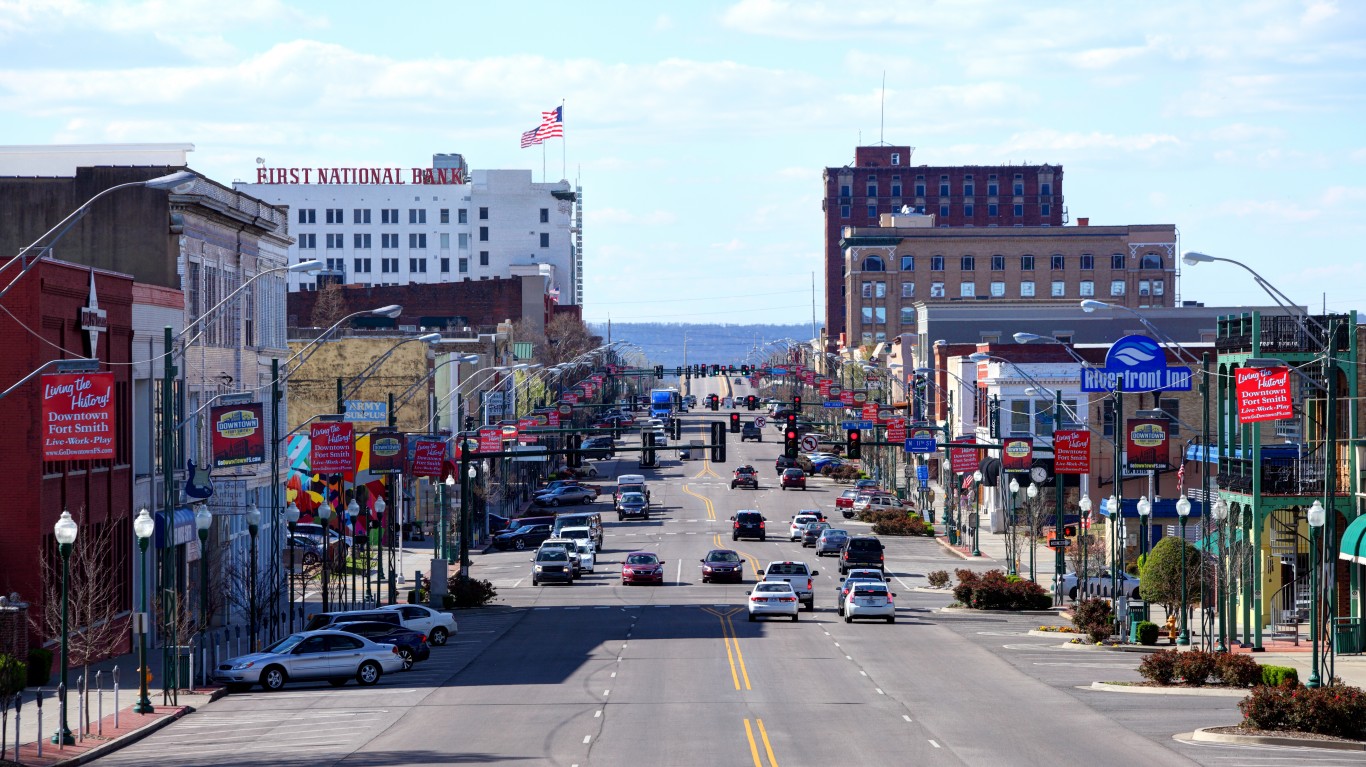
17. Fort Smith, AR-OK
> 2019 median annual wage: $30,690
> Most highly concentrated occupation: Meat, poultry, and fish cutters and trimmers (16.6 times more common than national distribution)
> Annual wage of area Meat, poultry, and fish cutters and trimmers: $24,230 (national median wage: $28,100)
> 2019 poverty rate: 19.4% (28th highest out of 383 metro areas)
Fort Smith reported among the lowest wages of any metro area in the U.S. in 2019, with an median annual wage of just $30,690, well below the overall U.S. median wage of $39,810 that year.
Poultry processing company OK Industries is one of the largest employers in Fort Smith. Poultry cutters and other jobs related to producing meat are among the most highly concentrated jobs in the Fort Smith area relative to their concentration nationwide. These workers tend to earn fairly low wages, with most in the area earning under $25,000 in 2019.
[in-text-ad-2]
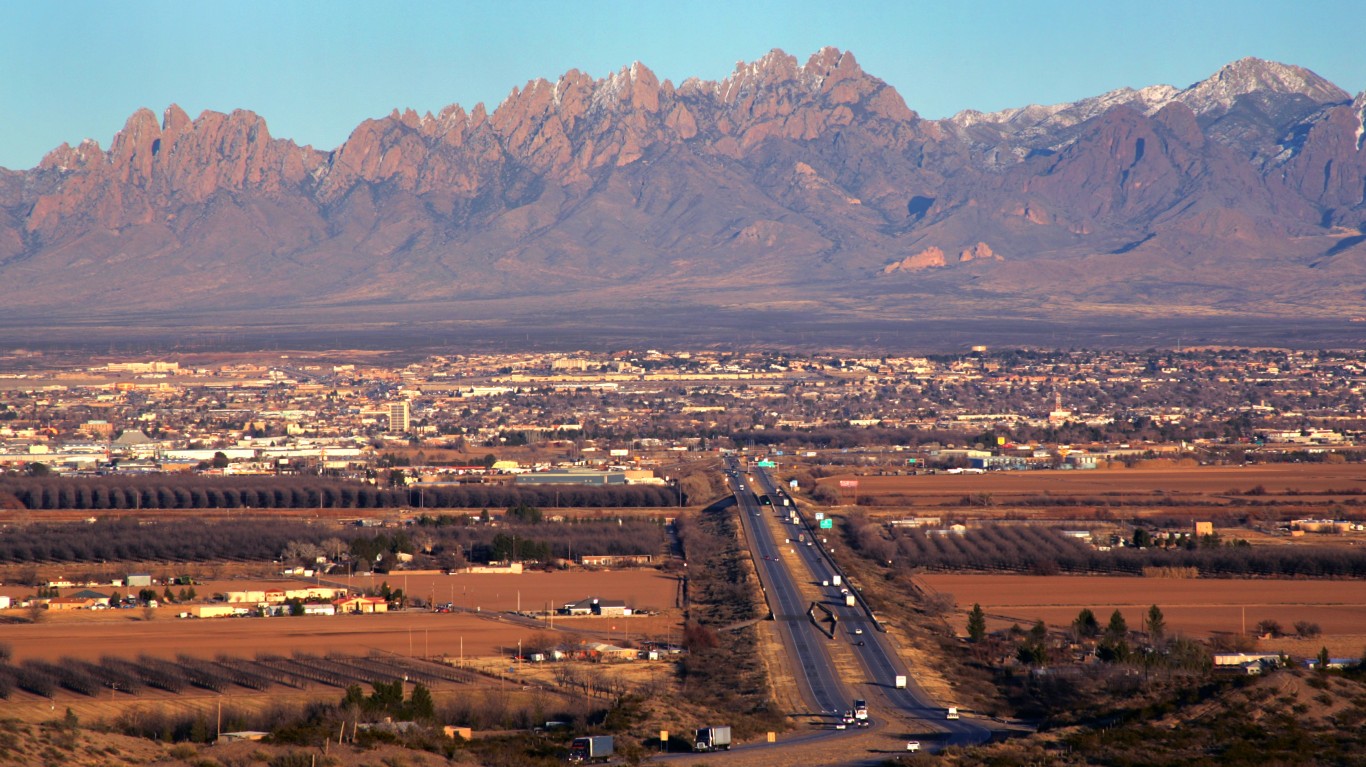
16. Las Cruces, NM
> 2019 median annual wage: $30,670
> Most highly concentrated occupation: Anthropologists and archeologists (15.1 times more common than national distribution)
> Annual wage of area anthropologists and archeologists: $54,660 (national median wage: $63,670)
> 2019 poverty rate: 25.9% (3rd highest out of 383 metro areas)
Las Cruces, New Mexico, is one of two U.S. metro areas on this list, along with Yuma, Arizona, that is not located in a Southern state. Las Cruces area residents are more than twice as likely as the typical American to live in poverty. Also, 11.6% of Las Cruces households lived on less than $10,000 in 2019, double the comparable U.S. rate.
Though the area has a relatively high concentration of high-paying jobs compared to the national concentration — like anthropologists, archaeologists, and professors at New Mexico State University — Las Cruces workers are more likely to work less than 35 hours per week and less than 50 weeks per year, driving down earnings.
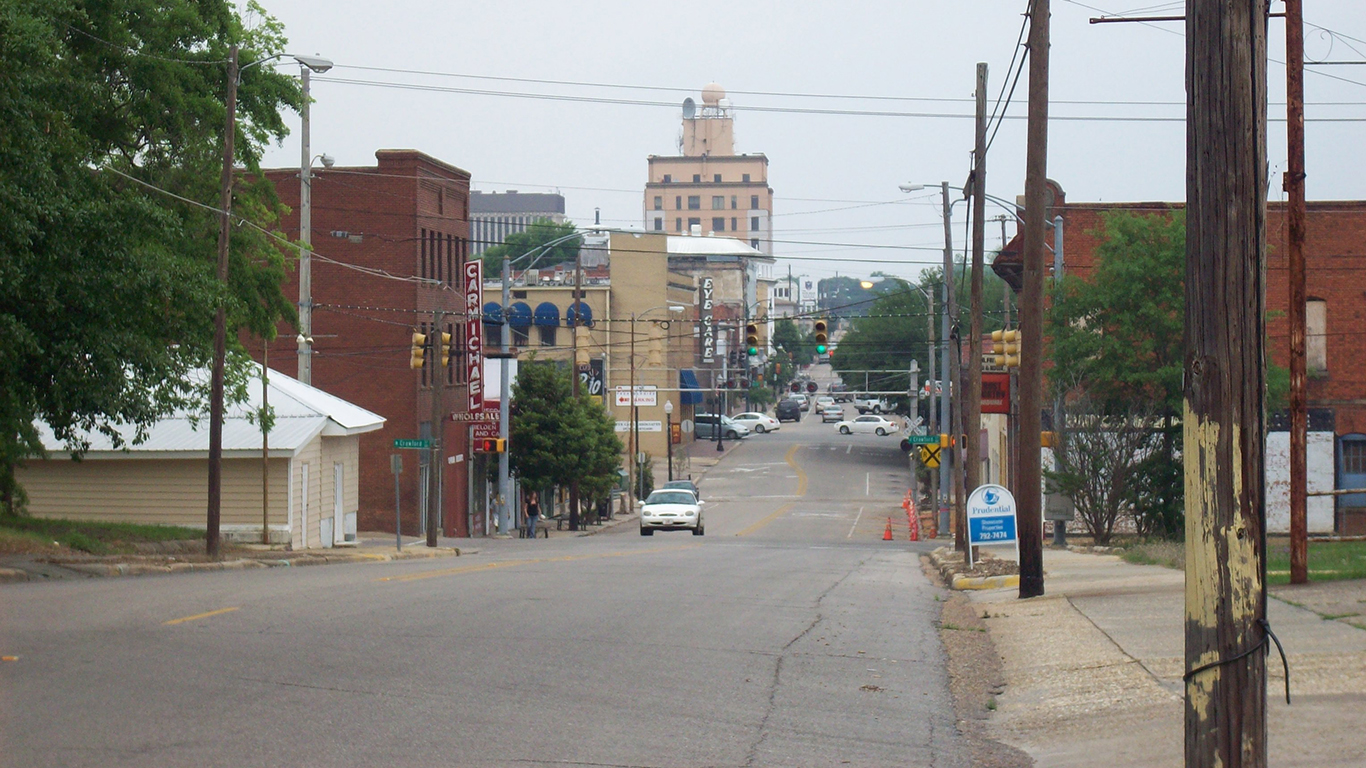
15. Dothan, AL
> 2019 median annual wage: $30,600
> Most highly concentrated occupation: Farmworkers, farm, ranch, and aquacultural animals (8.1 times more common than national distribution)
> Annual wage of area Farmworkers, farm, ranch, and aquacultural animals: $30,000 (national median wage: $27,830)
> 2019 poverty rate: 18.6% (38th highest out of 383 metro areas)
The Dothan area of southeastern Alabama has among the lowest paying jobs in America, with most workers earning less than $31,000 in 2019. Education and income are highly correlated, and just 20.1% of Dothan residents 25 and older hold at least a bachelor’s degree, compared to 33.1% of Americans that age overall.
More than a quarter of Dothan area nonfarm workers, 25.7%, work in the trade, transportation, and utilities sector. This service-providing industry generally does not offer high-paying jobs, contributing to the low wages of the area.
[in-text-ad]
14. Cleveland, TN
> 2019 median annual wage: $30,530
> Most highly concentrated occupation: Textile cutting machine setters, operators, and tenders (16.0 times more common than national distribution)
> Annual wage of area textile cutting machine setters, operators, and tenders: $22,610 (national median wage: $28,730)
> 2019 poverty rate: 15.2% (114th highest out of 383 metro areas)
In Cleveland, Tennessee, manufacturing jobs are more than twice as common as they are nationwide. Of the over 46,000 workers in the area, 19.0% work in manufacturing, compared to 8.5% of workers in the U.S.
The trade, transportation, and utilities sector employs the most workers in the Cleveland metro area, accounting for over 21% of jobs in the area. These jobs generally pay relatively low wages, and the median worker in the Cleveland area earned $30,530 in 2019.
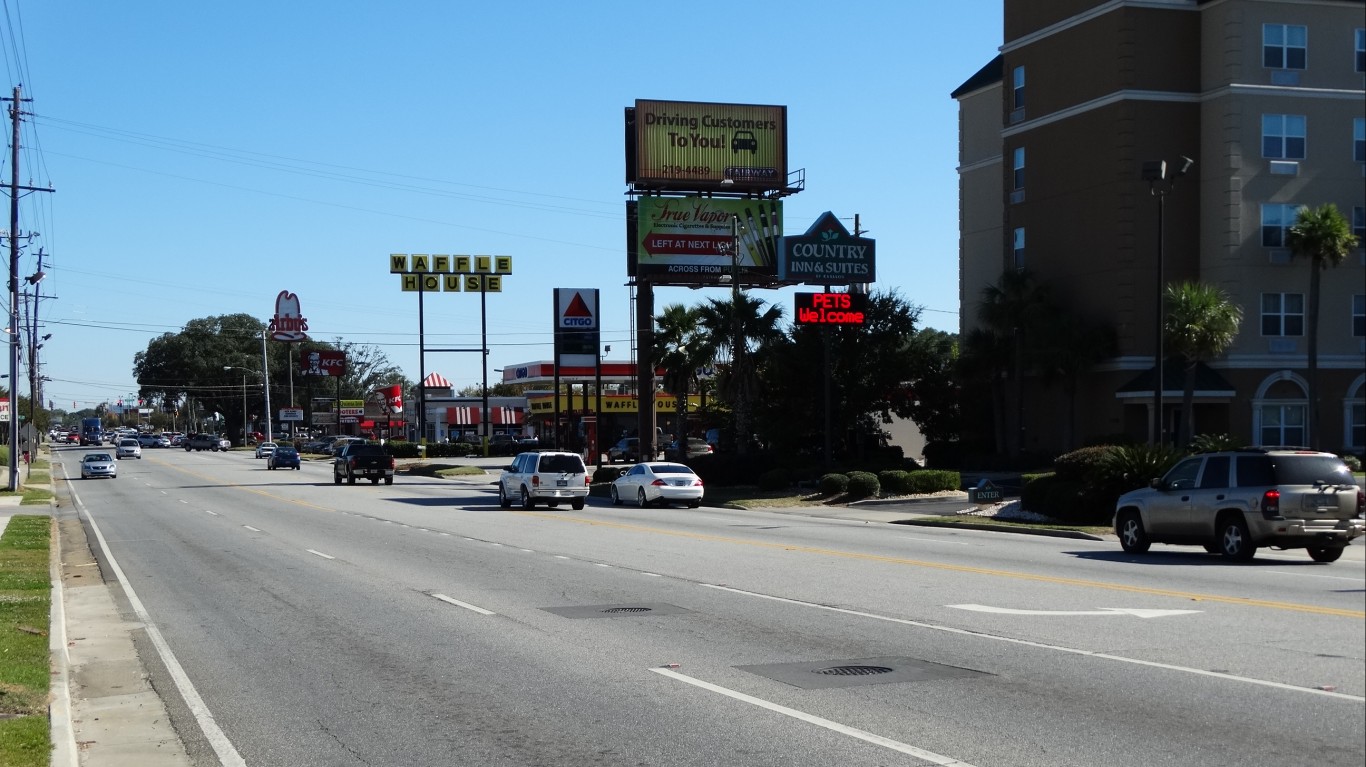
13. Valdosta, GA
> 2019 median annual wage: $30,230
> Most highly concentrated occupation: Farm equipment mechanics and service technicians (12.6 times more common than national distribution)
> Annual wage of area farm equipment mechanics and service technicians: $30,850 (national median wage: $42,200)
> 2019 poverty rate: 20.9% (15th highest out of 383 metro areas)
Across nearly 400 major metro areas, only a dozen had a lower 2019 median wage than Valdosta, Georgia, in the southern part of the state. The typical worker in the metro area earned $30,230 in 2019 — well below the U.S. median annual income of $39,810 that year.
In 2019, 22.6% of Valdosta area workers were employed in the trade, transportation, and utilities sector — a service-providing industry that includes retailing and warehousing, among other career fields. Nationwide, just 18.4% of workers were in this industry. The trade, transportation, and utilities sector generally does not have high wages, which may at least partially explain why the Valdosta metro area has among the lowest wages in America.

12. Jacksonville, NC
> 2019 median annual wage: $29,910
> Most highly concentrated occupation: Career/technical education teachers, postsecondary (7.5 times more common than national distribution)
> Annual wage of area career/technical education teachers, postsecondary: $55,740 (national median wage: $54,620)
> 2019 poverty rate: 11.1% (272nd highest out of 383 metro areas)
Jacksonville, which is near the eastern edge of North Carolina, is one of just a dozen U.S. metro areas in which most workers earned less than $30,000 in 2019. Despite having such a relatively low median annual wage, the Jacksonville area had just a 11.1% poverty rate in 2019 — one of just three metro areas on this list with lower poverty rates than 12.3% U.S. poverty rate.
Among the largest private employers in the Jacksonville metro area are large retail trade companies and food service vendors. These types of businesses often hire part-time workers and do not tend to pay high wages.
[in-text-ad-2]
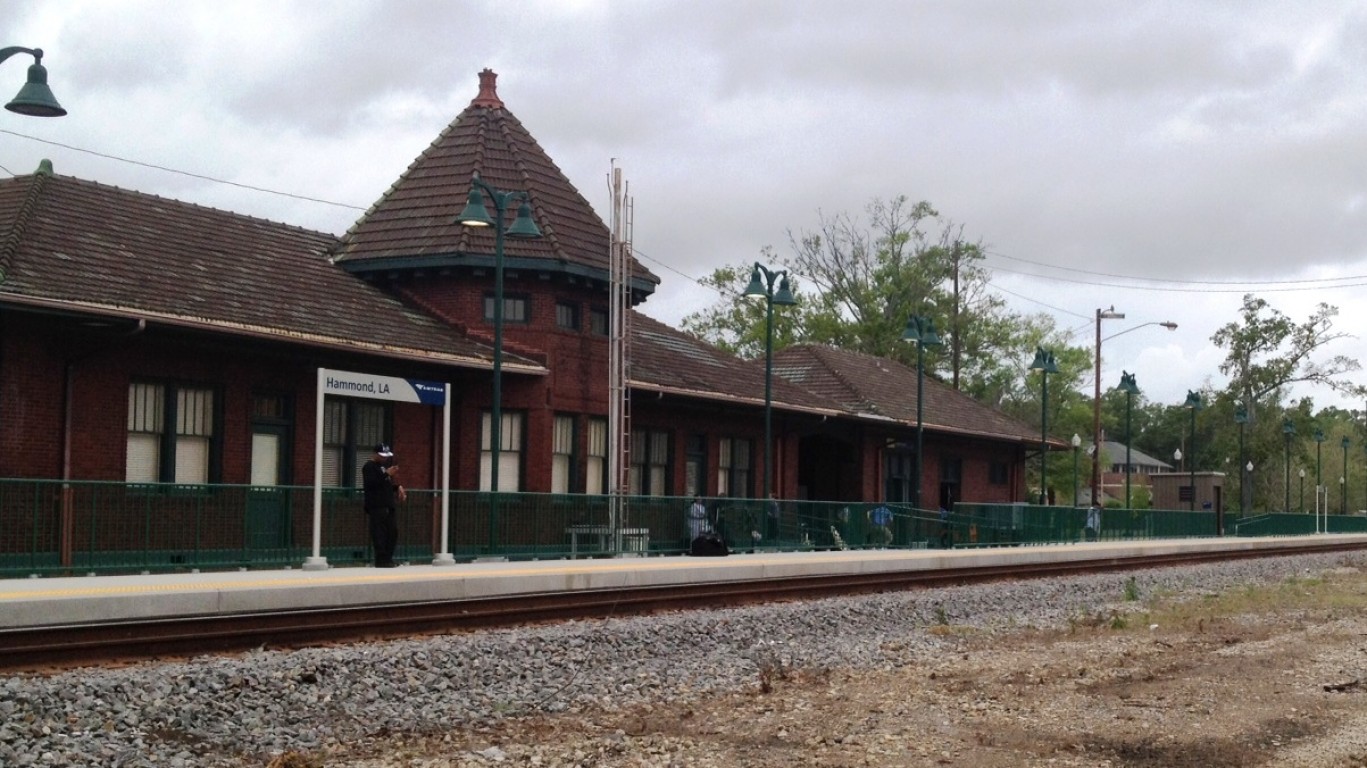
11. Hammond, LA
> 2019 median annual wage: $29,880
> 2019 poverty rate: 22.9% (7th highest out of 383 metro areas)
The Hammond, Louisiana, metro area is located north of New Orleans and east of Baton Rouge. Many of the area’s top private employers are in relatively low-paying industries like education, food processing, and retail. The relatively high frequency of these types of jobs helps to explain why most workers in the Hammond area earned less than $30,000 in 2019.
Education and income are closely linked, and the Hammond metro area has among the lowest educational attainment in the country. Just 84.1% of area residents 25 and older had at least a high school diploma, and 24.8% at least a bachelor’s degree, as of 2019.

10. Daphne-Fairhope-Foley, AL
> 2019 median annual wage: $29,750
> Most highly concentrated occupation: Motorboat mechanics and service technicians (16.7 times more common than national distribution)
> Annual wage of area motorboat mechanics and service technicians: $42,750 (national median wage: $41,330)
> 2019 poverty rate: 10.1% (306th highest out of 383 metro areas)
In 2019, the Daphne-Fairhope-Foley, Alabama, metro area reported among the 10 lowest annual wages, at just $29,750. This is more than $10,000 below the U.S. median annual wage that year.
The metro area spans much of the tip of southern Alabama around Mobile Bay. The median annual wage figure includes part-time workers, and as a coastal area, the Daphne metro area has a higher concentration of seasonal jobs. Nationwide, 61.7% of the U.S. working-age population worked 50 to 52 weeks in 2019. In the Daphne area, just 54.0% worked 50 or more weeks.
[in-text-ad]

9. Hattiesburg, MS
> 2019 median annual wage: $29,520
> Most highly concentrated occupation: Logging equipment operators (6.0 times more common than national distribution)
> Annual wage of area logging equipment operators: $39,090 (national median wage: $41,440)
> 2019 poverty rate: 22.5% (11th highest out of 383 metro areas)
In 2019, the typical worker in the Hattiesburg metro area of southern Mississippi earned just $29,520 — one of the lowest median wages in the nation, and not even within $10,000 of the U.S. median wage that year.
The two largest sectors in the Hattiesburg labor market are trade, transportation, and utilities and education and health services industries. The trade, transportation, and utilities industry generally does not have high wages. The education and health services sector tends to be mixed — teachers are generally not paid high wages, but some health services professions like doctors are among the highest paid workers in America. However, one of the most highly concentrated jobs relative to the national share of the workforce in the Hattiesburg area is psychiatric aides, a job in which most workers earn less than $23,000.
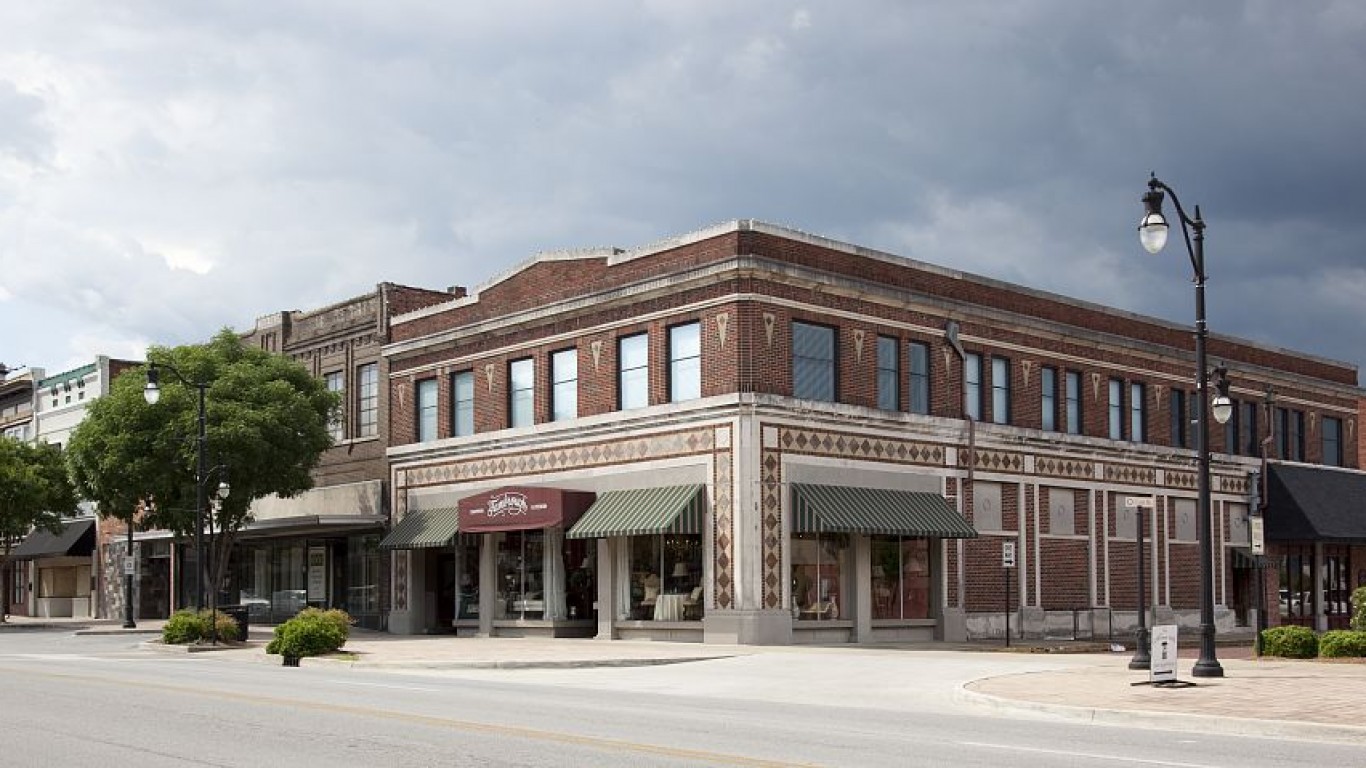
8. Gadsden, AL
> 2019 median annual wage: $29,210
> Most highly concentrated occupation: Helpers, production workers (22.3 times more common than national distribution)
> Annual wage of area helpers–production workers: $18,490 (national median wage: $29,100)
> 2019 poverty rate: 19.7% (25th highest out of 383 metro areas)
The Gadsden metro area in northeastern Alabama reported a 2019 median wage of $29,210, the eighth lowest out of 389 U.S. metro areas for which there is data. Education and income are highly correlated, and the Gadsden area has one of the lowest bachelor’s degree attainment rates in the nation. Just 17.2% of area residents 25 and older have a college degree, roughly half the U.S. rate of 33.1%.
The Gadsden metro area has a much higher than typical share of its workforce employed in the manufacturing sector. Nationwide, just 8.5% of workers are in manufacturing, but in Gadsden that figure is 14.1%. Manufacturing jobs are generally not highly skilled occupations and pay relatively low wages, helping explain Gadsden’s low median wages overall.
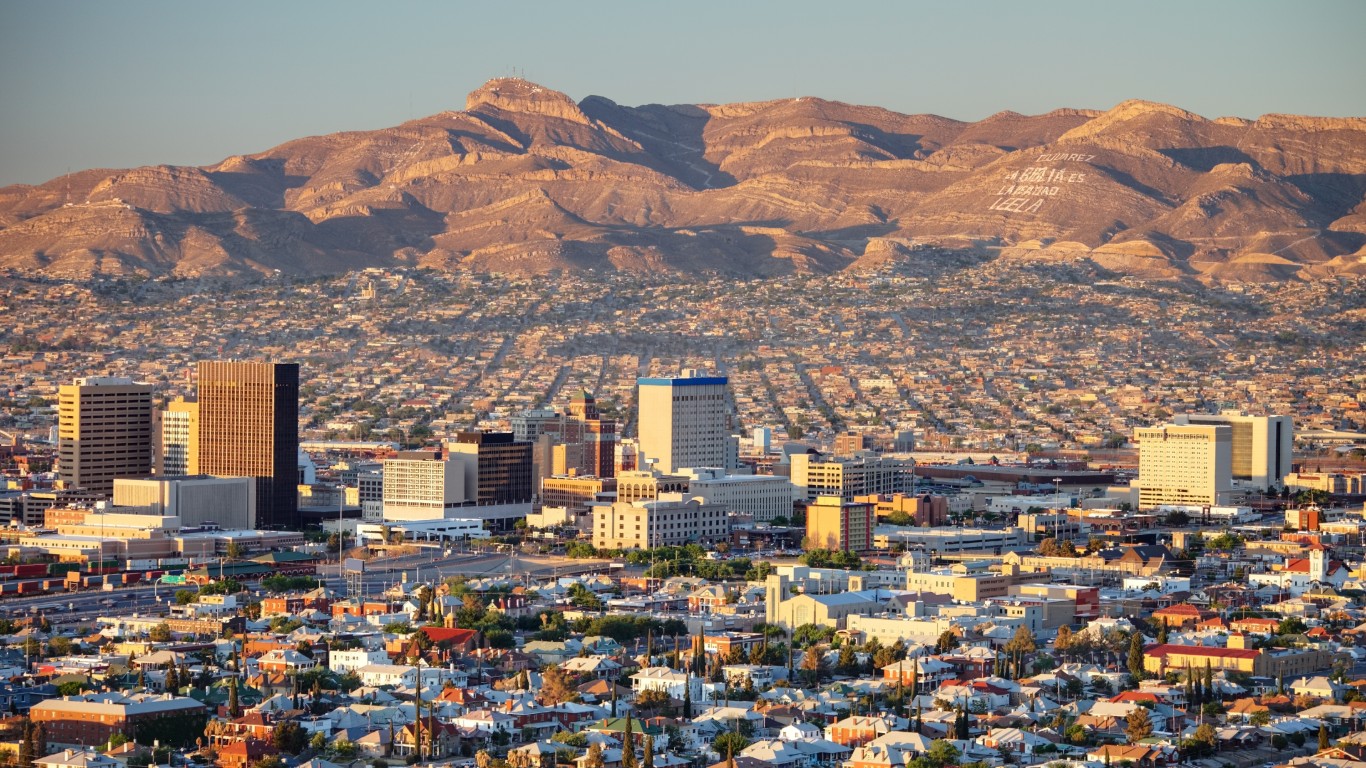
7. El Paso, TX
> 2019 median annual wage: $29,120
> Most highly concentrated occupation: Fire inspectors and investigators (8.4 times more common than national distribution)
> Annual wage of area fire inspectors and investigators: $46,530 (national median wage: $61,660)
> 2019 poverty rate: 18.7% (37th highest out of 383 metro areas)
El Paso, which is on the far western edge of Texas, is one of four metro areas along the Texas border with Mexico in which most workers earned less than $30,000 in 2019. Unsurprisingly, this area had a relatively high poverty rate in 2019, at 18.7%, compared to 12.3% nationwide.
The El Paso area has relatively high shares of its labor force working in lower-paying industries like trade, transportation, and utilities. It also has a lower than typical share of its workforce employed in higher-paying industries such as the information and financial activities industries.
[in-text-ad-2]

6. Sebring, FL
> 2019 median annual wage: $28,990
> Most highly concentrated occupation: Physical therapist aides (6.0 times more common than national distribution)
> Annual wage of area physical therapist aides: $24,210 (national median wage: $27,000)
> 2019 poverty rate: 14.4% (127th highest out of 383 metro areas)
The Sebring area of central Florida is one of just six major U.S. population centers in which most workers earned less than $29,000 in 2019. Sebring has the smallest workforce of any metro area on this list, with just 25,700 workers.
Of the 10 top employers in the Sebring metro area and surrounding county, four are in the health and social services industry. Though health care professionals like doctors earn high wages, others in the industry do not. For instance, physical therapy aide is the most highly concentrated job in the Sebring area relative to the occupation’s concentration in the U.S. workforce. These workers are mostly paid low wages, with most earning less than $25,000 in 2019.

5. Laredo, TX
> 2019 median annual wage: $28,590
> Most highly concentrated occupation: Detectives and criminal investigators (17.2 times more common than national distribution)
> Annual wage of area detectives and criminal investigators: $84,630 (national median wage: $83,170)
> 2019 poverty rate: 20.5% (18th highest out of 383 metro areas)
The most highly concentrated job in the Laredo area relative to the job’s concentration in the U.S. workforce is detectives and criminal investigators. These jobs are over 17 times more concentrated in the Laredo area than they are nationwide.
Incomes tend to increase with higher levels of education, yet Laredo area residents are among the least educated in the nation. Among metro area adults 25 and older, just 66.1% have a high school diploma, the lowest rate in the country. Laredo is the only place in the U.S. where fewer than two-thirds of adults have finished high school.
[in-text-ad]

4. Myrtle Beach-Conway-North Myrtle Beach, SC-NC
> 2019 median annual wage: $28,480
> Most highly concentrated occupation: Nuclear engineers (6.6 times more common than national distribution)
> Annual wage of area nuclear engineers: $112,650 (national median wage: $113,460)
> 2019 poverty rate: 11.8% (242nd highest out of 383 metro areas)
The Myrtle Beach metro area along the eastern edge of the North Carolina-South Carolina border is one of just six metro areas in which most workers earned less than $29,000 in 2019. However, with a relatively low poverty rate, the area is an outlier on this list.
Myrtle Beach is known as a popular tourist destination thanks to its pleasant weather and seaside location. Like many other vacation spots, many in the labor force work in seasonal or part-time jobs. The area’s working-age population — those ages 16 to 64 — were less likely to work 50 or more weeks a year or 35 or more hours per week in 2019, likely driving down the median annual wage.

3. Hot Springs, AR
> 2019 median annual wage: $28,190
> Most highly concentrated occupation: Motorboat mechanics and service technicians (16.3 times more common than national distribution)
> Annual wage of area motorboat mechanics and service technicians: $34,650 (national median wage: $41,330)
> 2019 poverty rate: 17.4% (59th highest out of 383 metro areas)
The Hot Springs, Arkansas, metro area had the third lowest median wage of any major population center in the U.S. in 2019, with the median worker pay at just $28,190, compared to the U.S. median wage of $39,810 that year.
Hot Springs, named for the naturally heated waters by the Ouachita Mountains nearby, is a popular tourist destination. Some of the most highly concentrated jobs in the area are in the service and hospitality industry, an employment sector in which workers tend to earn fairly low wages.
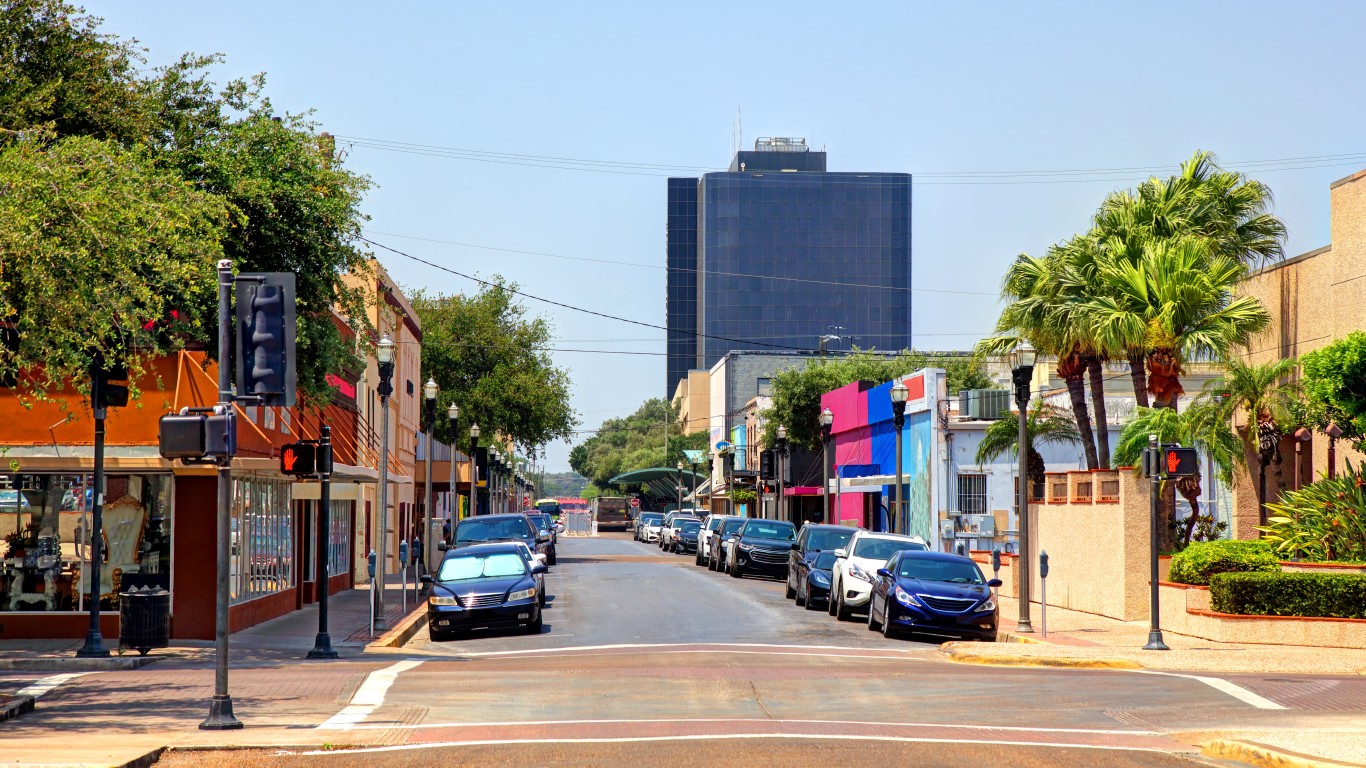
2. McAllen-Edinburg-Mission, TX
> 2019 median annual wage: $26,810
> Most highly concentrated occupation: Ambulance drivers and attendants, except emergency medical technicians (6.5 times more common than national distribution)
> Annual wage of area ambulance drivers and attendants, except emergency medical technicians: $22,560 (national median wage: $25,890)
> 2019 poverty rate: 27.3% (The highest out of 383 metro areas)
The McAllen metro area lies along Texas’ southern border with Mexico. Of the seven metro areas with the lowest paying jobs, four are along this same border.
In 2019, the three most highly concentrated jobs in the McAllen area, relative to their concentration in the U.S. workforce, were ambulance drivers, home health and personal care aids, and agricultural equipment operators. Most area workers in these career fields earned less than $23,000 in 2019. In large part because of these low-paying jobs, poverty is rampant in the McAllen area. At 27.3%, it is the highest poverty rate in the nation and more than double the 2019 U.S. poverty rate of 12.3%.
[in-text-ad-2]
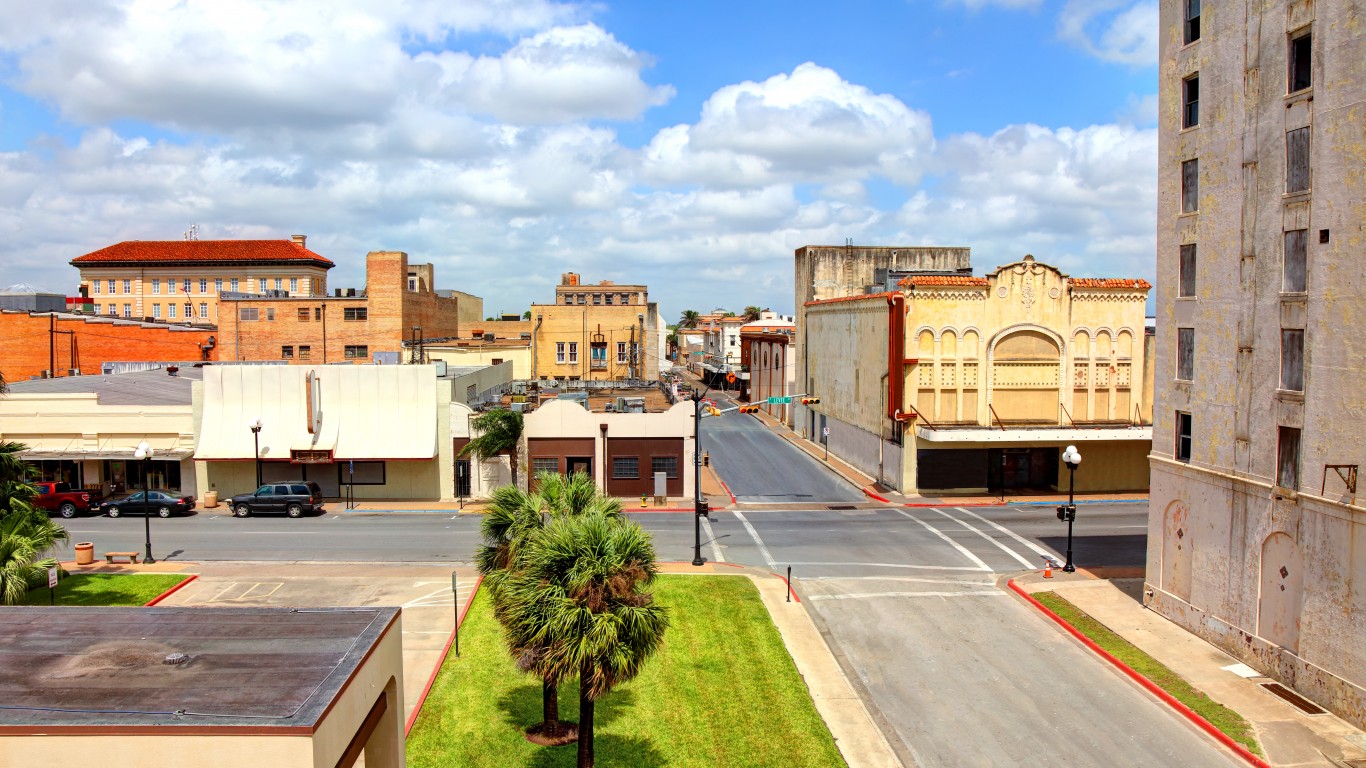
1. Brownsville-Harlingen, TX
> 2019 median annual wage: $24,910
> Most highly concentrated occupation: Pump operators, except wellhead pumpers (9.1 times more common than national distribution)
> Annual wage of area pump operators, except wellhead pumpers: $34,710 (national median wage: $45,040)
> 2019 poverty rate: 25.6% (4th highest out of 383 metro areas)
The Brownsville-Harlingen metro area at the southern tip of Texas is the only one of the nearly 400 U.S. metro areas in which most workers earned less than $25,000 in 2019. The area’s 2019 median wage was $24,910 — $1,900 lower than the next closest metro area, and nearly $15,000 less than the U.S. median wage that year.
Education and incomes are highly correlated, and Brownsville area adults have some of the lowest educational attainment rates in the nation. Just 68.3% of area residents 25 and older have finished high school, the third lowest percentage in the U.S. Also, just 17.1% hold at least a bachelor’s degree, just over half of the U.S. bachelor’s degree attainment rate.
Methodology
To identify the cities with the lowest paying jobs, 24/7 Wall St. reviewed the median annual wage in 389 metropolitan statistical areas using data from the May 2019 Occupational Employment Statistics program of the Bureau of Labor Statistics. Cities were ranked based on the median annual wage for all occupations.
The measure of concentration of various occupations is based on location quotient of employment, which also comes from the BLS OES. Location quotients are ratios measuring the relative concentration of jobs in an area compared to their concentration in the national workforce. Supplemental data on unemployment rates came from the BLS Local Area Unemployment Statistics program and is seasonally adjusted for December 2020.
Data on poverty rates came from the U.S. Census Bureau’s 2019 American Community Survey and figures are one-year estimates. Job categories defined as miscellaneous or that include the description “all other” were not considered for the most highly concentrated job. It should be noted that the data used is for 2019 and does not reflect changes to employment caused by COVID-19.
Cash Back Credit Cards Have Never Been This Good
Credit card companies are at war, handing out free rewards and benefits to win the best customers. A good cash back card can be worth thousands of dollars a year in free money, not to mention other perks like travel, insurance, and access to fancy lounges. See our top picks for the best credit cards today. You won’t want to miss some of these offers.
Flywheel Publishing has partnered with CardRatings for our coverage of credit card products. Flywheel Publishing and CardRatings may receive a commission from card issuers.
Thank you for reading! Have some feedback for us?
Contact the 24/7 Wall St. editorial team.
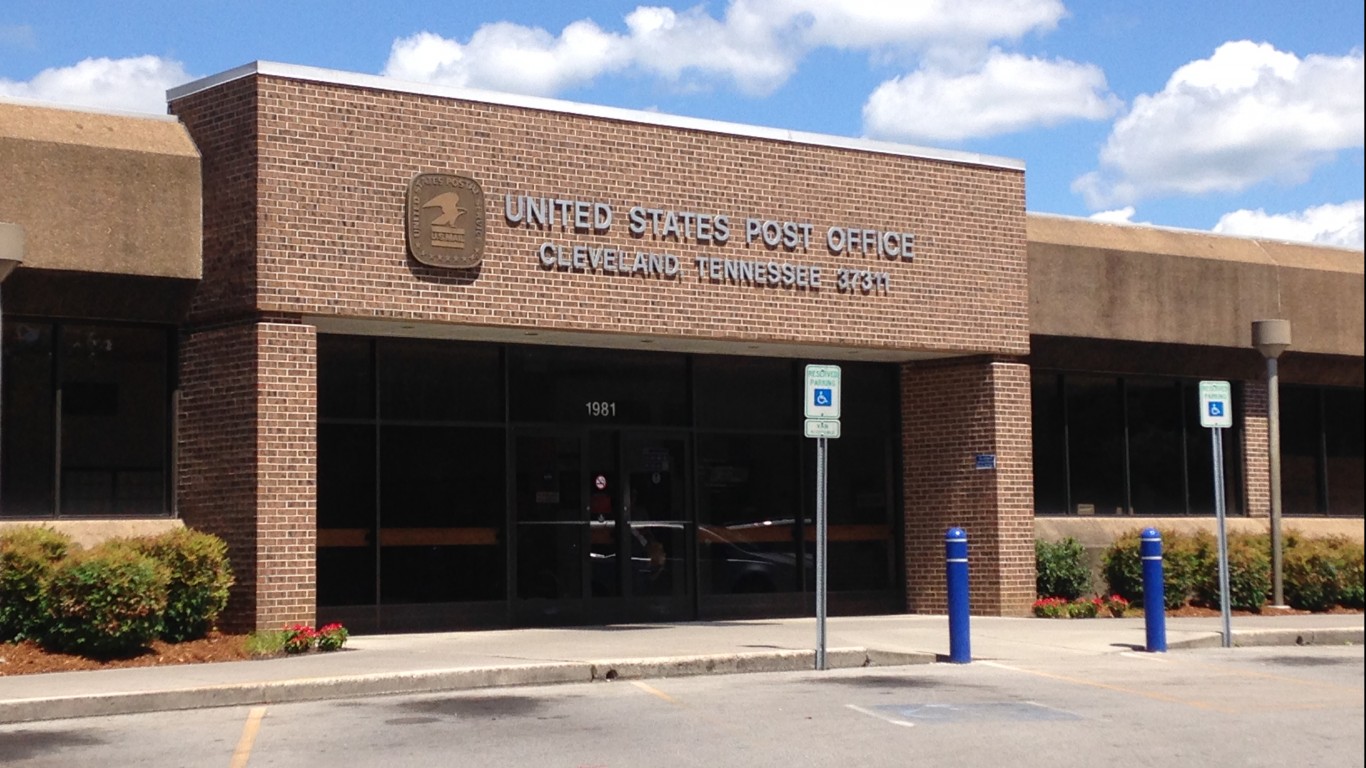
 24/7 Wall St.
24/7 Wall St. 24/7 Wall St.
24/7 Wall St.
